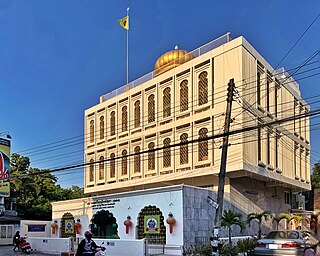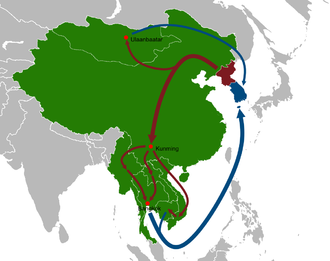
Chiang Mai, sometimes written as Chiengmai or Chiangmai, is the largest city in northern Thailand, the capital of Chiang Mai province and the second largest city in Thailand. It is 700 km (435 mi) north of Bangkok in a mountainous region called the Thai highlands and has a population of 1.2 million people as of 2022, which is more than 66 percent of the total population of Chiang Mai province.

Phuket is one of the southern provinces (changwat) of Thailand. It consists of the island of Phuket, the country's largest island, and another 32 smaller islands off its coast. It lies off the west coast of mainland Thailand in the Andaman Sea. Phuket Island is connected by the Sarasin Bridge to Phang Nga province to the north. The next nearest province is Krabi, to the east across Phang Nga Bay.

A Koreatown, also known as a Little Korea or Little Seoul, is a Korean-dominated ethnic enclave within a city or metropolitan area outside the Korean Peninsula.

Pattaya is a city in Eastern Thailand, the second-largest city in Chonburi province and the eight-largest city Thailand. It is on the east coast of the Gulf of Thailand, about 100 kilometres (62 mi) southeast of Bangkok, and has a population of 328,961 as of 2021.

Sukhumvit Road, or Highway 3, is a major road in Thailand, and a major surface road of Bangkok and other cities. It follows a coastal route from Bangkok to Khlong Yai District, Trat border to Koh Kong, Cambodia.

Tourism is an economic contributor to the Kingdom of Thailand. Estimates of tourism revenue directly contributing to the GDP of 12 trillion baht range from one trillion baht (2013) 2.53 trillion baht (2016), the equivalent of 9% to 17.7% of GDP. When including indirect travel and tourism receipts, the 2014 total is estimated to be the equivalent of 19.3% of Thailand's GDP. The actual contribution of tourism to GDP is lower than these percentages because GDP is measured in value added not revenue. The valued added of the Thailand's tourism industry is not known. According to the secretary-general of the Office of the National Economic and Social Development Council in 2019, the government projects that the tourism sector will account for 30% of GDP by 2030, up from 20% in 2019.

Sikhism is a recognised minority religion in Thailand, with about 70,000 adherents. The religion was brought by migrants from India who began to arrive in the late 19th century. There are about twenty Sikh temples or Gurdwaras in the country, including the Gurdwara Sri Guru Singh Sabha in Bangkok.
Koreans in Indonesia numbered 78,676 individuals as of 2018, making them the 13th-largest population of overseas Koreans, according to South Korea's Ministry of Foreign Affairs. The number has increased significantly from the previous record, which was around 50,000 people.
Korean Canadians are Canadian citizens of full or partial Korean ancestry, as well with immigrants from North and South Korea. As of 2016, Korean Canadians are the 8th largest group of Asian Canadians.

Golf arrived in Thailand during the reign of King Rama V at the Royal Bangkok Sports Club and Royal Hua Hin Golf Course. It was first played by nobles and other elites of high society but is now played by a wider segment of the population. Retail and fashion industries golf promotions are popular in the Si Lom Road part of Bangkok in Thaniya Plaza shopping mall.

Denmark–Thailand relations date back to 1621. Denmark operates an embassy in Bangkok, along with a consulate in Phuket, although it used to have one in Pattaya. The Danish embassy in Bangkok also handles Danish relations with Cambodia, with the current Danish ambassador of Thailand also being the ambassador to Cambodia. Thailand itself operates an embassy in Copenhagen.
Nepalese in Thailand comprise migrants from Nepal to Thailand, including expatriates and permanent residents, as well as their locally born descendants.

Visitors to Thailand must obtain a visa from one of the Thai diplomatic missions unless they come from a visa-exempt country or a country whose citizens are eligible to obtain visas on arrival/eVisa.
Japanese migration to Thailand has a long history and in recent years has grown. As of 2021, the Ministry of Foreign Affairs reports that Thailand has the fourth highest number of Japanese expatriates in the world after the United States, China and Australia. Bangkok, the home of two-thirds of all the registered Japanese residents in Thailand, has the second-largest Japanese expatriate population of any city in the world outside Japan, behind only Los Angeles. Japanese residents themselves suspect that their actual population number may be several times higher than the official figures, because many transient residents, especially those on long-term tourist visas, fail to register with Japanese consulates.

The Thai addressing system is used to identify a specific location in Thailand. It generally corresponds closely with the administrative divisions of Thailand.
The meetings, incentives, conferencing, exhibitions (MICE) industry in Thailand is one of the major branches of tourism in Thailand, contributing an estimated 0.58 percent to Thailand's GDP in 2012.

Thailand–Turkey relations are the modern foreign relations between Thailand and Turkey. The cordial relations between the two countries date back to 1958, when the two countries established diplomatic relations. Shortly after, Turkey set up its embassy in Bangkok. Thailand reciprocated by opening its embassy in 1972. However, even during the era of the Ottoman Empire, there had been historical contacts between the Empire and Siam at the time -- most notably the visit of Prince Damrong, younger brother of King Chulalongkorn the Great of Siam, to Istanbul as the royal guest of Sultan Abdul Hamid II in 1891.













